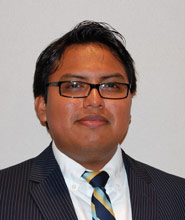LIM COLLEGE FACULTY BLOG
Factors that Shape the Mathematics Identities of Young Women
posted by Dr. Anahu Guzman, Associate Chair of Arts & Sciences, Director of the Math Center
Dr. Guzman recently gave a lecture on the subject of young women and their perception of math abilities as part of the Marcuse Lecture Series.
If we reminisce about our experiences in learning mathematics, we would recall experiences that are deep-rooted in our memory. Some may be pleasant, meaningful, and others may be traumatizing.
 None the less, those experiences contribute to who we are as mathematics doers. In an effort to understand how young women interpret their mathematics experiences inside and outside the classroom, and how those experiences have defined who they are as mathematics doers, I conducted a semester long qualitative study. The results of my study were drawn from mathematics autobiographies, one questionnaire, two interviews, and three class observations.
None the less, those experiences contribute to who we are as mathematics doers. In an effort to understand how young women interpret their mathematics experiences inside and outside the classroom, and how those experiences have defined who they are as mathematics doers, I conducted a semester long qualitative study. The results of my study were drawn from mathematics autobiographies, one questionnaire, two interviews, and three class observations.
There are various ways that researchers have studied and defined identity. Most of the current work on identity and identity construction use a sociological approach. An example of that is Danny Martin’s work which I used as the theoretical framework for my study.
He defines mathematics identity as an individual’s “beliefs about their ability to perform in mathematical contexts, the instrumental importance of mathematical knowledge, constrains and opportunities in mathematical contexts, and the resulting motivations and strategies used to obtain mathematics knowledge.”
One of the emerging themes in my study was the belief that some people are born with a natural ability to do mathematics. Plato argued that “those who are by nature good at calculation are as one might say, naturally sharp in every other study…” This natural ability to do mathematics have been mostly attributed to men.
In Fennema, Peterson, and Carpenter’s 1990 study showed that teachers attributed female students’ success to effort and male students’ success to ability. However, there is a lack of evidence of the existence of a “Math Gene.”
In my study, non-successful students believed the existence of people who born with the ability to do mathematics and self-ascribe a lack of that natural ability. However, most successful students attributed their success to having a natural ability to do mathematics.
Another emerging theme among the collected data for this study was the belief about being a certain “type of person,” – English or math. As these group of young women were growing up, some of them saw mathematics as a “boy’s subject.” They argued that they were mostly encouraged to read books and were expected to be great writers. Some participants mentioned that boys were expected to do better in mathematics, “that’s how socially” we are supposed to be.
James P. Gee argues that individuals shape or engage in behaviors and practices in order to belong to an affinity group. Perhaps the engagement of this group of young women in a mathematics class and their identification with mathematics can be explained by the type of person they believed themselves to be.
The third factor that I addressed during my presentation was the influence that games and fun activities in previous mathematics classes had among young women’s mathematics identities. When I asked participants questions regarding their favorite mathematics class, they all make sure to express that at some point in time, they have enjoyed mathematics class. Their eyes opened up and their body language changed during the interviews as they recalled the fun in-class activities and games.
These activities were meaningful for them as they accepted and engaged on the requirements of these activities. However, these activities had an unintended message about what defines someone to be good in mathematics. They belief that if one is good in mathematics, then one should be able to solve mathematics problems fast and sometimes without using paper and pencil. For some of them, this belief influenced their confidence in doing mathematics. When they were taking advance course in high school such as Precalculus, some came to believe that they were not as good as they have believed they were in mathematics when they started to take longer to solve problems and sometime they needed assistance.
The last factor I addressed during my presentation was at the intrapersonal level. It address the instrumental importance of mathematics for this group of young women. The work of Na'ilah Suad Nasir was critical to understand participants’ motivation to learn mathematics.
This group of young women argued that they were engaged and motivated to learn mathematics when there was a link to who they want to be in their professional lives and the mathematics they were learning was not constraint to their mathematics classroom. Their willingness to learn mathematics depended on their instructor’s ability to connect mathematics to their set goals. Jo Boaler claims that “Mathland, the fantasy world created by many mathematics questions, is likely to be most harmful to those students who are socially aware and concerned about the relevance of subjects to their future lives – often these students are girls.”
As educators and parents, it is important to understand that the construction of mathematics identities is an on-going process. It is in our hands to provide our students with the opportunities to foster positive mathematics identities and empower female students to fight the misconceptions about their ability to do mathematics and make mathematics no longer be seen as a male domain.
Want to find out more about the LIM College Center for Math? Go to this page!
Topics: math center, perception, young women, math abilities